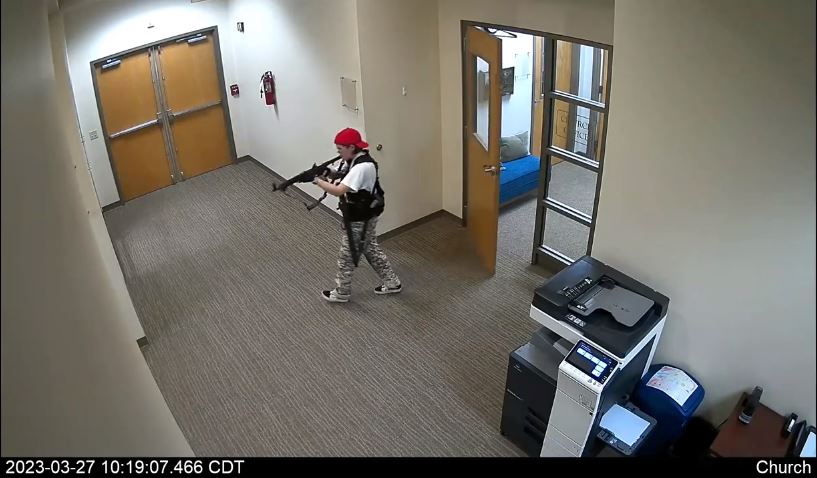
By Dave Workman
Editor-in-Chief
High-profile mass shootings were definitely among the top stories affecting gun rights in 2023, and perhaps the most significant because of the swiftness with which it was stopped by a handful of courageous police officers was the Covenant School incident on March 27 in Nashville, Tenn.
Police responded quickly arriving about ten minutes after the first report. They entered the building at approximately 10:23 a.m. and by 10:27 a.m., the killer was dead.
Three students and three staff, including school administrator Katherine Koonce, were killed.
The speed officers displayed in tracking down and killing the shooter—an apparently disturbed individual identified as Audrey Elizabeth Hale, who was described as a “transgender man” going by the name Aiden Hale and had once been a student at the school—contrasted stunningly with responses at the Marjory Stoneman Douglas High School shooting in Parkland, Fla., and the Robb Elementary School shooting in Uvalde, Tex. Body cam video of the Nashville incident was quickly released, showing officers quickly checking classrooms and making their way to the school’s second floor where they found Hale and shot her dead.
Hale left a manifesto, portions of which were apparently released, but the entire document has yet to be officially made public. It was also revealed Hale had purchased seven firearms, passing background checks in the process, and that she had no criminal history.
The New York Times this week published a lengthy article about the aftermath, and the push for stricter gun control laws in Tennessee.
More than two months before the Nashville shooting, a killer identified as Anthony Dwayne McRae, opened fire at Michigan State University killing three people and wounding five others. Following an intensive manhunt spanning about three hours, police confronted McRae, who fatally shot himself.
It was revealed McRae had a previous legal problem for carrying a gun without a concealed carry license. The charge was plea bargained down to a misdemeanor, so he was legally able to purchase firearms.
Then in October, a madman opened fire at two locations in Lewiston, Maine, killing a total of 18 people. Gunman Robert Card was found two days later, in a container, dead from a self-inflicted gunshot wound.
The Associated Press reported Card legally purchased the gun(s) he used, and that police had recovered several firearms during their investigation.
Card had been hospitalized in New York while on duty with the National Guard at the U.S. Military Academy at West Point, and had been “acting erratically” in mid-July.
Mass Shooting Defined
The aftermath of such incidents typically ignites a debate over what, exactly, constitutes a “mass shooting.” The problem is that there is no uniform definition.
The FBI, defines a mass shooting as “Four or more murders occurring during the same incident, with no distinctive time period between the murders. These events typically involve a single location, where the killer murdered a number of victims in an ongoing incident.”
However, the oft-quoted Gun Violence Archive says this: “Mass Shootings are, for the most part an American phenomenon. While they are generally grouped together as one type of incident they are several with the foundation definition being that they have a minimum of four victims shot, either injured or killed, not including any shooter who may also have been killed or injured in the incident.”
Then there’s the K-12 School Shooting Database, which muddies the water even more by stating, “All shootings at schools includes when a gun is brandished, is fired, or a bullet hits school property for any reason, regardless of the number of victims, time, or day of the week.
“How many school shootings this year? Unlike other data sources, this information includes gang shootings, domestic violence, shootings at sports games and afterhours school events, suicides, fights that escalate into shootings, and accidents.”
Politifact probably explains the dilemma best, stating, “But a definitive answer to how many mass shootings there have been is difficult, because organizations tracking such shootings use different methodologies and definitions. By one count, there have been 68 mass shootings so far in 2023 (including the one at Michigan State University). By other counts, there have been six — or even fewer. These widely divergent numbers can create confusion in the wake of another tragedy.”
The one common thread with each incident is the aftermath, in which gun control proponents invariably call for more restrictions on gun owners, as though this would somehow prevent criminals or crazy people from committing violent crimes.
The debate will continue in 2024, as state legislatures meet, and Congress looks at legislation on Capitol Hill. Everyone will be mindful of the upcoming election campaigns at all levels of government, and it will remain to be seen in November whether voters support or reject politicians who climb on the gun control bandwagon.



